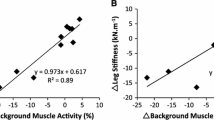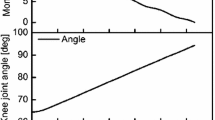Abstract
The neuromuscular characteristics of the triceps surae and vastus lateralis muscles and interactions between the pre-activation of these muscles and the muscle output itself during ground contact were investigated during various types of stretch-shortening cycle muscle loading. The loading of the muscles was effected by using three different types of drop jump exercise. These jumps allowed separate modifications of the loading of the leg extensor muscles by changing the velocity of the centre of gravity (CG) or by changing directly the body mass, which was also affected by changing artificially the acceleration of the CG. It was found that the eccentric peak angular velocity of the ankle joint was related to the various precontact and eccentric parameters in all the different types of jumping exercise. The correlations were higher for the gastrocnemius muscle (P < 0.001) than for the soleus muscle (n.s., P < 0.01). In all the experimental conditions, the pre-activation of the measured muscles started well before the impact of contact with the ground. However, the duration of the pre-activation phase depended on the type of stretch exercise. The results would suggest a clear interaction between the pre-activation of the muscles and that part of the muscle output which is effected by the segmental stretch reflex system. The control mechanism of the pre-activation itself appears to be multiple in character. It seems reasonable to assume that the pre-activation is preprogrammed, but which can, however, be modified by proprioceptive, vestibular and visual inputs. Thus, the possibility of conscious modification of the expected muscle load must be considered.
Similar content being viewed by others
References
Asmussen E, Bonde-Petersen F (1974) Storage of elastic energy in skeletal muscles in man. Acta Physiol Scand 91:385–392
Avela J, Santos PM, Kyröläinen H, Komi PV (1994) Effects of different simulated gravity conditions on neuromuscular control in drop jump exercises. Aviat Space Environ Med 65:301–308
Burke D, Hagbarth K-E, Löfstedt L (1978) Muscle spindle activity in man during shortening and lengthening contractions. J Physiol (Lond) 277:131–142
Cavanagh PR, Komi PV (1979) Electromechanical delay in human skeletal muscle under concentric and eccentric contractions. Eur J Appl Physiol 42:159–163
Dietz V (1992) Human neuronal control of automatic functional movements: interaction between central programmes and afferent input. Physiol Rev 72:33–69
Dietz V, Horstmann GA, Trippel M, Gollhofer A (1989) Human postural reflexes and gravity — an under water simulation. Neurosci Lett 106:350–355
Dietz V, Schmidtbleicher D, Noth J (1979) Neuronal mechanism of human locomotion. J Neurophysiol 12:1212–1223
Dietz V, Noth J, Schmidtbleicher D (1981) Interaction between preactivity and stretch reflex in human triceps brachii landing from forward falls. J Physiol (Lond) 311:113–125
Dyhre-Poulsen P, Mosfeldt Laurensen A (1984) Programmed electromyographic activity and negative incremental muscle stiffness on monkeys jumping downward. J Physiol (Lond) 350:121–136
Dyhre-Poulsen P, Simonsen EB, Voigt M (1991) Dynamic control of muscle stiffness and H reflex modulation during hopping and jumping in man. J Physiol (Lond) 437:287–304
Frigo C, Pedotti A (1978) Determination of muscle length during locomotion. In: Asmussen A, Jorgensen K (eds) International series of biomechanics, biomechanics VI-A. Park Press, Baltimore, pp 355–360
Gollhofer A (1987) Innervation characteristics of muscle gastrocnemius during landing on different surfaces. In: Johnson B. (ed) International Series of Biomechanics. Biomechanics X-B. Human Kinetic Champaign In., pp 701–706
Gollhofer A, Kyröläinen H (1991) Neuromuscular control of the human leg extensor muscles in jump exercises under various stretch-load conditions. Int J Sports Med 12:34–40
Gollhofer A, Schmidtbleicher D, Dietz V (1984) Regulation of muscle stiffness in human locomotion. Int J Sports Med 5:19–22
Gollhofer A, Strojnik V, Rapp W, Schweizer L (1992) Behaviour of triceps surae muscle-tendon complex in different jump conditions. Eur J Appl Physiol 64:283–291
Gottlieb GL, Agarwal GC (1979) Response to sudden torques about ankle in man: myotatic reflex. J Neurophysiol 42:91–106
Grabiner MD (1986) Bioclectric characteristics of the electomechanical delay preceding concentric contraction. Med Sci Sports Exerc 1:37–43
Greenwood R, Hopkins A (1976) Muscle response during sudden falls in man. J Physiol (Lond) 254:505–518
Hancock J (1985) Motor cortical discharges and locomotion in the cat. J Physiol (Lond) 364:28P
Hunter IW, Kearney RE (1982) Dynamics of human ankle stiffness: variation with mean ankle torque. J Biomech 15:747–752
Kaneko M, Komi PV, Aura O (1984) Mechanical efficiency of concentric and eccentric exercises performed with medium to fast contraction rates. Scand J Sport Sci 1:15–20
Komi PV (1984) Physiological and biomechanical correlates of muscle function: effects of muscle structure and stretch shortening cycle on force and speed. Exerc Sport Sci Rev 12:81–121
Komi PV, Bosco C (1978) Utilization of stored elastic energy in leg extensor muscles by men and women. Med Sci Sports 10:261–265
Komi PV, Gollhofer A, Schmidtbleicher D, Frick U (1987) Interaction between man and shoe in running: considerations for a more comprehensive measurement approach. Int J Sports Med 8:196–202
Kyrölänen H, Avela J, Komi PV (1989) Regulation of muscle force and stiffness during long jump take-off. XII International Congress on Biomechanics, Congress Proceedings. University of California, Los Angeles pp 364–365
Lee RG, Tatton WG (1982) Long loop reflexes in humans: clinical applications. In: Desmedt JE (ed) Cerebral motor control in man: long loop mechanism. Progr Clin Neurophysiol 4. Karger, Basel, pp 334–341
Matthews PBC (1986) Observations on the automatic compensation of the reflex gain on varying the preexisting level of motor discharge in man. J Physiol (Lond) 374:73–90
Mellvill Jones G, Watt D (1971) Observation on control of jumping and hopping movements in man. J Physiol (Lond) 219:709–727
Moritani T, Oddson L, Thorstensson A (1991) Activation patterns of the soleus and gastrocnemius muscles during different motor tasks. J Electromyogr Kinesiol 1:81–88
Nichols TR, Houk JC (1976) Improvement in linearity and regulation of stiffness that results from actions of stretch reflex. J Neurophysiol 39:119–142
Nicol C, Komi PV, Horita T, Kyröläinen H, Takala TES Reduced stretch-reflex sensitivity after exhaustive stretch-shortening cycle (SSC) exercise (in press).
Schmidtbleicher D, Gollhofer A (1982) Neuromuskuldre Untersuchungen zur Bestimmung individueller Belastungsgrössen fur ein Tieftsprungtraining. Leistungsport 12:298–307
Toft E, Sinkjaer T, Andreassen S (1989) Mechanical and electromyographic responses to stretch of the human anterior tibial muscle at different levels of contraction. Exp Brain Res 74:213–219
Toft E, Sinkjaer T, Andreassen S, Larsen K (1991) Mechanical and electromyographic responses to stretch of the human ankle extensors. J Neurophysiol 6:1402–1410
Vos EJ, Harlaar J, van Ingen Schenau GJ (1991) Electromechanical delay during knee extensor contractions. Med Sci Sports Exerc 10:1187–1193
Author information
Authors and Affiliations
Rights and permissions
About this article
Cite this article
Avela, J., Komi, P.V. & Santos, P.M. Effects of differently induced stretch loads on neuromuscular control in drop jump exercise. Eur J Appl Physiol 72, 553–562 (1996). https://doi.org/10.1007/BF00242290
Accepted:
Issue Date:
DOI: https://doi.org/10.1007/BF00242290




